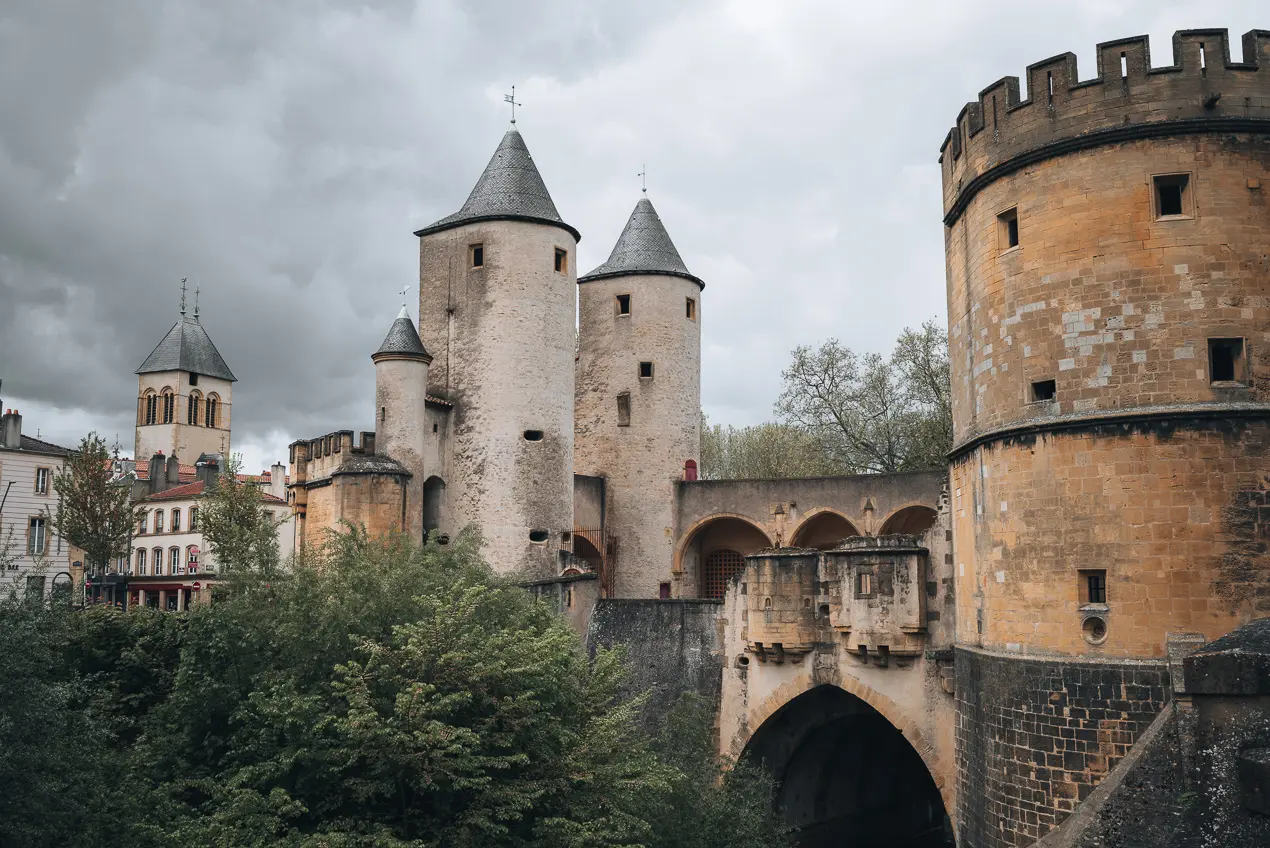Paris, the City of Light, stands as a beacon of culture, history, and art in the heart of Europe. This city is world-renowned for its iconic landmarks like the Eiffel Tower, the Louvre Museum, and the Notre-Dame Cathedral. However, Paris’s allure doesn’t end at its city limits. Beyond the bustling streets and the serene banks of the Seine lies a treasure trove of unusual yet captivating day trips from Paris. These places are perfect for those looking to step off the well-trodden path and dive into unique experiences that are as enriching as they are memorable.
The appeal of exploring these less-known destinations lies in the opportunity they offer to immerse oneself in the diverse tapestry of French culture, history, and natural beauty. Each destination serves as a window into the past, presenting tales of glory, intrigue, and revolution, while also offering a glimpse of France’s natural splendor. For travelers looking to enrich their Parisian adventure with a dash of the extraordinary, these unusual day trips promise an escape from the city’s hustle and bustle, leading into worlds untouched by the typical tourist.
One such destination is the town of Provins, a UNESCO World Heritage Site that offers a deep dive into medieval history. Here, visitors can explore well-preserved fortifications, towers, and underground passages that tell the tale of a bustling trading town in the Middle Ages. The experience is like stepping back in time, with the added thrill of witnessing reenactments and medieval festivals that bring history to life in vibrant color.
Nature enthusiasts and adventurers might find their curiosity piqued by the Forest of Fontainebleau. This vast woodland area, dotted with massive boulders and scenic trails, is a paradise for climbers, hikers, and outdoor lovers. The forest also embraces the Château de Fontainebleau, a former royal residence that showcases French architecture and history from the Renaissance to the Napoleonic era.

Paris
Another hidden gem is the city of Troyes, with its remarkable medieval and Renaissance architecture. This town, once the capital of the Champagne region, is characterized by its unique, narrow, and colorful half-timbered houses that line the old town’s winding streets. Troyes is also famous for its culinary delights, offering a taste of authentic French cuisine and, of course, Champagne.
Lastly, for a truly off-the-beaten-path experience, the Oise-Aisne American Cemetery and Memorial provides a solemn but profound day trip. This site commemorates the American soldiers who fought and died in World War I. The beautifully maintained cemetery and memorial offer a place of reflection on the sacrifices made for freedom, providing a poignant contrast to the lively streets of Paris.
These unusual day trips from Paris offer a rich palette of experiences that go beyond the conventional tourist attractions. They invite travelers to explore the depth of French culture, history, and natural beauty. Each destination provides a unique story and a different perspective on France, making them perfect for those seeking to enrich their Parisian adventure with unforgettable memories.
Exploring the Loire Valley’s Hidden Corners
Exploring the Loire Valley from Paris offers a day trip into a world where the French Renaissance still whispers through the air, amidst a landscape dotted with vineyards and lesser-known chateaux. The Loire Valley, celebrated for its breathtaking castles and rich viticulture, holds within it corners that remain untouched by the usual flurry of tourists. This journey isn’t just about stepping away from Paris for a day; it’s an invitation to immerse oneself in the authentic charm and hidden gems of one of France’s most picturesque regions.
Getting to the Loire Valley from Paris is a seamless experience, thanks to the efficient French rail system. The express train, departing from Paris’ Montparnasse station, swiftly transports travelers into the heart of this UNESCO World Heritage Site in just a couple of hours. The convenience of the train journey allows for an early start and a full day of exploration, making it an ideal option for those looking to maximize their time away from the bustling streets of Paris.
Once in the Loire Valley, the adventure begins with the discovery of its less frequented estates. These chateaux, while not as famous as their counterparts like Chambord or Chenonceau, offer a unique glimpse into the life of nobility during the Renaissance period. Visiting these estates, guests can enjoy a more intimate experience, often with the opportunity to meet the caretakers or owners who are more than willing to share the history and stories behind these magnificent properties.
The Loire Valley is also renowned for its extensive vineyards, producing some of the most exquisite wines in the world. A trip to this region would be incomplete without delving into its viticulture. Many vineyards offer wine tastings and tours, providing insight into the winemaking process, from grape cultivation to bottling. These experiences are not just about tasting wine; they’re an education in the delicate art of viniculture, highlighting the region’s variety from crisp whites to velvety reds.

Loire Valley
What makes these tours particularly special is the emphasis on small, intimate groups. This approach ensures that visitors can fully appreciate the beauty and tranquility of the Loire Valley without the crowds. It’s an opportunity to connect more deeply with the history and culture of the region, making the experience all the more personal and memorable.
Moreover, these day trips from Paris to the Loire Valley highlight the region’s commitment to preserving its natural and architectural heritage. By focusing on less-visited sites and sustainable wine production practices, these tours contribute to the conservation of the valley’s unique landscape and history for future generations.
In essence, a day trip to the Loire Valley from Paris is more than just a brief escape from city life. It’s a journey into a region that continues to captivate with its stories, beauty, and flavors. The ease of travel, combined with the allure of its hidden corners, makes the Loire Valley an ideal destination for those seeking to uncover the lesser-known facets of French history and culture. Whether it’s wandering through the halls of a quiet chateau, strolling among the vines, or savoring the complexity of a local wine, the Loire Valley offers a day of exploration that feels worlds away from the hustle and bustle of Paris.
Burgundy: A Culinary Journey
Embarking on an unusual day trip from Paris, the journey to Burgundy offers an exceptional experience that marries culinary excellence with breathtaking landscapes. This region, famous for its contributions to the culinary world and viticulture, provides a unique adventure for those looking to explore beyond the French capital’s confines.
Burgundy, a testament to France’s deep-rooted culinary traditions, is particularly celebrated for its rich gastronomy. A notable highlight is Dijon, the capital of the Burgundy region, which holds a historical significance in the world of mustard making. Dijon mustard, known for its distinctive flavor, is a result of centuries-old traditions. Visitors to Dijon have the opportunity to explore various mustard shops and even participate in mustard-making workshops. These experiences offer a deeper understanding of why Dijon mustard has become a staple in kitchens around the world.
Apart from its culinary delights, Burgundy is also renowned for its picturesque landscapes, which are best enjoyed through the region’s scenic canal cruises. These leisurely boat rides offer panoramic views of the countryside, adorned with vineyards that stretch as far as the eye can see. It’s an opportunity to relax and immerse oneself in the tranquil beauty of Burgundy, making it a perfect counterpoint to the bustling streets of Paris
For wine enthusiasts, a day trip to Burgundy would be incomplete without a wine tasting tour. The region is famous for its climats, a term that refers to the unique combination of climate, soil, and topography that contributes to the diversity of Burgundy’s wines. A wine tasting tour allows visitors to delve into the nuances of Burgundy wines, understanding how each climat influences the character and taste of the wine. It’s not only an educational experience but also a sensory journey through the flavors that define one of the world’s most celebrated wine regions.
Travel tips for those planning to venture into Burgundy include considering the “Wine Tasting & Visits- Private Day Trip From Paris” tour. This carefully curated experience is designed to offer an intimate exploration of Burgundy’s wine culture. It typically includes visits to several wineries, where guests can taste a variety of wines and learn about the winemaking process from the vintners themselves. The private nature of the tour ensures a more personalized experience, allowing for in-depth conversations and a pace that suits the preferences of the visitors.
To make the most of a day trip to Burgundy, it’s advisable to plan ahead. Booking tours in advance is recommended, especially during peak tourist seasons, to ensure availability.
Lastly, while the focus might be on wine and food, Burgundy’s historical sites, such as the Hospices de Beaune, should not be overlooked. This former hospital, now a museum, is an architectural marvel and offers insights into the region’s history and culture.
A day trip to Burgundy from Paris transcends the ordinary, offering a blend of culinary exploration, historical insights, and natural beauty. It’s an invitation to experience the heart and soul of French culinary and wine traditions, set against the backdrop of one of the country’s most picturesque regions. Whether a connoisseur or simply curious, Burgundy promises an enriching and unforgettable adventure.
Château Vaux-le-Vicomte: A Historical Gem
A mere 55 kilometers southeast of Paris, Château Vaux-le-Vicomte emerges as a captivating day trip destination, offering an enchanting experience far removed from the bustling tourist paths leading to Versailles. This majestic estate, a masterstroke of 17th-century French architecture and garden design, encapsulates the zenith of French elegance and the intricate dance of power, art, and history.
Constructed between 1658 and 1661 for Nicolas Fouquet, Louis XIV’s superintendent of finances, Vaux-le-Vicomte is a testament to the brilliance of its creators: architect Louis Le Vau, painter-decorator Charles Le Brun, and landscape architect André Le Nôtre. This trio, whose collaboration here would later be reprised on an even grander scale at Versailles, imbued the chateau and its surroundings with a harmonious blend of architectural innovation and aesthetic splendor.
The chateau’s history is as dramatic as its architecture is stunning. Its unveiling in 1661, through an opulent celebration attended by the young Louis XIV, ultimately led to Fouquet’s downfall. The king, envious of Fouquet’s magnificent residence and suspicious of his financial dealings, had him arrested shortly thereafter. Yet, despite its creator’s tragic fate, Vaux-le-Vicomte stands today as a monument to his vision and the artistry of his collaborators.
Visitors to Vaux-le-Vicomte are treated not just to its well-preserved interior, replete with period furniture and decorations, but also to the breathtaking French gardens that unfurl over 33 hectares. These gardens, designed by Le Nôtre, are a marvel of symmetry and perspective, inviting guests on a leisurely journey through manicured lawns, ornamental basins, and sculptured hedges.

Château Vaux-le-Vicomte
One of the most magical experiences at Vaux-le-Vicomte is its candlelit evenings. Held on select dates from May through October, these events see the chateau and its gardens illuminated by 2,000 candles, creating an atmosphere of ethereal beauty and romance. The experience is further enhanced by live classical music performances, making for an unforgettable evening under the stars.
Accessing Château Vaux-le-Vicomte from Paris is straightforward, making it an ideal choice for those looking to explore beyond the city’s confines. The most convenient route involves taking a train from Paris Gare de l’Est to Melun, followed by a short taxi or shuttle bus ride to the chateau.
Unlike Versailles, which can often feel overwhelming due to its sheer scale and the throngs of visitors it attracts, Vaux-le-Vicomte offers a more intimate glimpse into France’s royal past. The estate’s lesser-known status means that guests can enjoy its splendors at a more leisurely pace, often finding themselves alone in its vast gardens or quietly exploring its ornate rooms without the hustle and bustle found at more popular sites.
Beyond Borders: Antwerp, Belgium
Day trips from Paris are a marvelous way to extend the adventure beyond the French capital’s borders, discovering the charm and distinctiveness of nearby regions and countries. One such destination that promises an unforgettable experience is Antwerp, Belgium. Just a couple of hours from Paris by train, this vibrant city invites visitors to immerse themselves in its rich blend of culture, architecture, and world-renowned diamond trade.
Antwerp is a city where history and modernity collide in the most fascinating ways. It’s a place that doesn’t just welcome visitors; it embraces them with open arms, offering an array of experiences that cater to art lovers, fashion enthusiasts, history buffs, and everyone in between. A day trip here allows one to step into a world where every street and alleyway tells a story, every building reflects centuries of architectural evolution, and the air itself seems infused with creativity and innovation.
One cannot discuss Antwerp without highlighting its extraordinary connection to the diamond industry. The city is known as the diamond capital of the world, with about 80% of the world’s diamonds passing through here at some point. The Diamond District, near the central station, is a must-visit. Even those not looking to buy will find the window-shopping and the sheer scale of the trade here utterly fascinating. The district buzzes with the activities of cutters, traders, and jewelers, providing insight into an industry that has shaped the city’s fortunes for centuries.
However, Antwerp’s allure extends far beyond its glittering diamonds. The city is a canvas for architectural exploration, showcasing styles from Gothic to Renaissance to modernist marvels. The Cathedral of Our Lady stands as a testament to Gothic grandeur, housing works by Peter Paul Rubens, the city’s most famous son. Then there’s the Antwerp Central Station, often referred to as the ‘Railway Cathedral,’ which blends stone, glass, and metal to create a transport hub that’s as much a piece of art as it is a gateway to the city.

Antwerp, Belgium
Art enthusiasts will find a kindred spirit in Antwerp. The Royal Museum of Fine Arts and the Museum Plantin-Moretus, a UNESCO World Heritage site, offer deep dives into the artistic and cultural heritage of the region. Meanwhile, contemporary art galleries and street art installations dot the city, showcasing the vibrant and ever-evolving local art scene.
Exploring Antwerp is best done on foot or by bike, allowing one to fully absorb the multicultural ambiance that permeates the city. The diverse culinary scene here is a testament to its multicultural fabric, with Belgian classics like waffles and chocolates taking their place alongside international cuisines. The city’s fashion scene is also noteworthy, with the Antwerp Six putting it on the global fashion map in the 1980s. Today, fashionistas can wander through the Fashion District, exploring boutiques and designer stores that showcase the innovative spirit of the city.
Discovering Laon: A Medieval Cathedral Town
Paris, the city of light, love, and endless cultural offerings, can sometimes overshadow the treasure trove of day trip destinations that lie within a short train ride from its bustling streets. Among these hidden gems is Laon, a medieval cathedral town that offers a stark contrast to Paris with its tranquil charm and impressive historical significance. A visit to Laon is not just a journey through space but also through time, as one wanders through its ancient streets, dominated by the imposing presence of its Gothic cathedral.
Laon sits majestically atop a hill, overseeing the plains of the Aisne region in Northern France. This elevated position not only provides breathtaking views of the surrounding countryside but also historically served as a strategic vantage point, making Laon a place of significant military and political power in medieval France. Today, however, it’s the town’s remarkable preservation of its medieval character and architecture that draws visitors.
The centerpiece of Laon’s historic charm is, without a doubt, the Cathedral of Notre-Dame de Laon. This architectural masterpiece of Gothic style, constructed between the 12th and 13th centuries, is renowned for its towering spires, remarkable sculptures, and the oxen statues that adorn its towers, a homage to the animals that contributed to the construction of this magnificent edifice. The cathedral’s interior is equally impressive, with its stained glass windows casting colorful light across the nave, creating a serene ambiance that transports visitors back in time.
Exploring the town further, visitors will discover Laon’s well-preserved medieval center, with its cobbled streets and traditional buildings, some of which date back to the 12th century. Walking these ancient streets offers a sense of the town’s past vibrancy and importance. The ramparts that once protected the town now offer a peaceful path for visitors to explore, providing stunning views of the cathedral and the countryside beyond.

Laon
For a leisurely exploration of Laon, it’s advisable to set aside the rush and allow the town’s quiet beauty to reveal itself. A guided tour can provide insight into the town’s rich history and architectural details, but wandering aimlessly can be just as rewarding. The town center is compact enough to explore on foot, and the absence of the hustle and bustle found in larger cities makes it a perfect setting for a relaxed day out.
Adding to the experience, Laon has several small museums and art galleries that showcase the town’s history and cultural heritage. The Musée d’Art et d’Archéologie, housed in a former bishop’s palace, contains artifacts from the region’s past, from prehistoric times through to the Middle Ages and beyond, providing context to the architectural wonders of the town.
Reaching Laon from Paris is straightforward, with direct trains available that connect the two cities in about an hour, making it an easily accessible retreat from the city’s hustle. The train journey itself is a pleasant prelude to the day ahead, with scenic views of the French countryside whizzing by.
A day trip to Laon offers a unique opportunity to immerse oneself in the medieval history and architecture of Northern France. It’s a reminder of the rich tapestry of cultures and epochs that lie just beyond the periphery of modern city life, awaiting discovery. In Laon, the past is not just preserved in stone and mortar but felt in the quiet streets and serene vistas, making it an ideal destination for those looking to explore the depth of France’s historical landscape.
Lille: A Fusion of French and Belgian Cultures
Lille, a city often overlooked in favor of its more glamorous French neighbors, presents a delightful amalgamation of French sophistication and Belgian allure. This city is a testament to the seamless blend of cultures, architecture, and culinary traditions that characterize the border regions of France and Belgium. As one ventures just a few hours from Paris, they are greeted by a city that defies expectations, offering a unique mix of experiences that captivate both the casual visitor and the discerning traveler.
The historic center of Lille, with its cobbled streets and grandiose squares, invites exploration on foot. This area, a vibrant heart of the city, is home to a range of architectural marvels from different eras, each telling its own story of the city’s past. From the grand Place Charles de Gaulle, dominated by the Vieille Bourse, a stunning example of 17th-century Flemish renaissance architecture, to the quaint charm of the Vieux Lille, the old town brimming with boutiques, cafes, and museums, there’s a palpable sense of history and culture at every turn.
Gastronomy in Lille is another highlight, blending French culinary finesse with hearty Belgian influences. The city’s eateries and bistros serve up an array of dishes that satisfy the palate with a mix of flavors and textures. Traditional French cuisine, renowned worldwide for its delicacy and sophistication, finds a unique expression here, infused with the robust, earthy flavors typical of Belgian fare. Local specialties, such as carbonnade flamande (a beer-braised beef stew), moules-frites (mussels served with fries), and an assortment of locally produced cheeses and beers, showcase the region’s rich culinary heritage.

Lille city
Travelers to Lille are often surprised by the city’s understated beauty and charm. Unlike the opulent grandeur of Paris or the sun-drenched streets of the French Riviera, Lille’s beauty is subtle, woven into the fabric of its streets and buildings, and the warmth of its people. The city exudes an inviting atmosphere, where the blend of cultures creates a welcoming environment for all who visit. Seasonal events, like the famous Lille Braderie, the largest flea market in Europe held annually in September, bring the city to life, offering glimpses into the local traditions and communal spirit that define this region.
The fusion of French elegance and Belgian charm in Lille offers a unique day trip option for those looking to explore beyond the confines of Paris. The city’s walkable historic center, culinary delights, and the element of pleasant surprise in its beauty make it a destination that enriches the travel experience.
Château de Sceaux: Secret French Gardens
Exploring the areas surrounding Paris offers a treasure trove of experiences, particularly for those looking to escape the well-trodden paths of the city’s more famous attractions. Among these, the Château de Sceaux stands out as a delightful destination for an unusual day trip. Located just a short RER ride away from the heart of Paris, this historic estate provides a serene and splendid escape, presenting an appealing alternative to the often overcrowded grounds of Versailles.
The journey to Château de Sceaux itself is an easy and efficient one, utilizing the RER B line that connects central Paris to the suburb of Sceaux. This convenience allows travelers to transition quickly from the urban intensity of Paris to the tranquil beauty of one of France’s lesser-known gems. Upon arrival, visitors are greeted by the majestic presence of the château, which serves as a stunning example of classical French architecture.
The real allure of Château de Sceaux, however, lies in its expansive gardens. Designed by André Le Nôtre, the celebrated landscape architect who also masterminded the gardens of Versailles, the grounds of Sceaux offer a similarly grandiose yet more intimate experience. The gardens are a masterpiece of symmetry and perspective, showcasing meticulous lawns, ornate statues, and serene water features. Unlike the often crowded avenues of Versailles, the gardens here invite leisurely exploration, often providing moments of solitude and reflection amidst the meticulously arranged nature.

château de sceaux
Beyond the visual appeal of its gardens, Château de Sceaux offers a glimpse into the history and culture of France. The château houses the Musée de l’Île-de-France, a museum dedicated to the history and art of the Île-de-France region, which includes Paris and its surrounding areas. This museum presents an intriguing narrative of the region’s development, from medieval times through to the modern day, and offers visitors a deeper understanding of the cultural backdrop against which the château and its gardens were created.
The appeal of Château de Sceaux extends through the seasons. In spring, the estate is famous for its cherry blossoms, drawing visitors who come to admire the pink hues that blanket the park. Summer offers lush greenery and vibrant flower beds, perfect for picnics and leisurely strolls. Autumn transforms the park with a palette of warm colors, while winter reveals the stark beauty of the château’s architecture against a sometimes snowy landscape.
In sum, the Château de Sceaux presents an excellent day trip option for those looking to explore beyond Paris’s city limits. Its proximity to the capital, combined with the stunning beauty of its gardens and the rich cultural offerings of its museum, make it a compelling destination for anyone interested in the beauty and history of France. As a less crowded alternative to Versailles, it offers a more relaxed and personal experience, ensuring that visitors can truly absorb the tranquility and beauty of this exceptional French estate.
Metz, Rennes, Senlis, Amboise, Luxembourg City, and Bruges
Exploring beyond the periphery of Paris unveils an array of captivating day trips, each distinct in character and history. Metz, Rennes, Senlis, Amboise, Luxembourg City, and Bruges serve as remarkable gateways to the diverse cultural and architectural heritage of Europe, ranging from Gothic cathedrals and medieval streets to Renaissance châteaux and bustling market squares.
Metz is a gem on the Moselle River, inviting with its blend of German and French cultures. The city’s centerpiece, the Metz Cathedral, is famed for its stunning stained-glass windows, some designed by Marc Chagall. The Pompidou Center’s satellite museum, a beacon of contemporary art, contrasts with the ancient, cobblestoned lanes. For travelers, Metz is about a 1.5-hour train ride from Paris, making it a straightforward journey for those keen on soaking up Franco-Germanic influences.
Rennes, the capital of Brittany, is an animated city with a vibrant student population that infuses life into its historical core. The Parlement of Brittany and the sprawling Thabor Park are must-visits, alongside exploring the colorful timber-framed houses of the old town. The local markets are a feast for the senses, offering Breton specialties. Rennes is approximately 2 hours from Paris by train, suggesting an early start for day-trippers.
Senlis offers a quieter, though no less charming, retreat. This medieval town boasts a well-preserved historic center, crowned by its ancient cathedral and surrounded by remnants of Gallo-Roman and medieval walls. The nearby Chantilly Castle adds to the area’s allure, providing a mix of aristocratic heritage and vast, manicured gardens. At just about an hour’s drive from Paris, Senlis is an easy escape to the past.

Metz, city
Amboise is synonymous with the Renaissance in France, primarily due to its association with King Francis I and Leonardo da Vinci. The Château d’Amboise, perched above the Loire River, provides panoramic views and a glimpse into royal life. Close by, the Château du Clos Lucé, where da Vinci spent his final years, houses models of his inventions. About a 2-hour train journey from Paris, Amboise is a dive into the heart of French Renaissance history.
Luxembourg City, the capital of the Grand Duchy, might seem an ambitious day trip, but its compact size and high-speed train connections (around 2 hours from Paris) make it feasible. The city is renowned for its fortified medieval old town perched on sheer cliffs, its cosmopolitan atmosphere, and its mix of European institutions. The Bock Casemates and the Grand Ducal Palace are highlights, along with the city’s many bridges and viewpoints.
Bruges, often referred to as the Venice of the North, is the furthest stretch for a day trip but undoubtedly rewarding. Famous for its well-preserved medieval architecture, the city’s canals, market square, and the Belfry offer a journey back in time. Belgian chocolate and lace shops line the cobbled streets, enhancing the experience. While it’s a longer journey, about 2.5 to 3 hours by train with a transfer in Brussels, Bruges promises a day of enchantment.
Conclusion
Paris, a city renowned for its enchanting streets, historical monuments, and vibrant cultural scene, also serves as a gateway to a host of unique and less-traveled day trip destinations. From medieval towns and châteaux to natural wonders and artistic enclaves, these destinations are easily accessible and promise to enrich your travel narrative with unforgettable stories.
One such destination is the town of Provins, located a short train ride from Paris. Unlike the more famous medieval cities, Provins is a UNESCO World Heritage site that remains off the radar for most tourists. Here, you can walk through well-preserved medieval gates, wander around the ancient market squares, and explore underground tunnels that date back to the 12th century. The highlight is the impressive calendar of medieval-themed events, including jousting tournaments and falconry shows, that transport visitors back in time.
For art enthusiasts, the village of Barbizon offers a completely different vibe. Before Impressionism took the art world by storm, Barbizon was the heart of the pre-Impressionist movement, where artists like Jean-François Millet and Théodore Rousseau sought inspiration from nature. Today, visitors can explore the studios and homes of these artists, now turned into museums, and take leisurely walks in the surrounding Fontainebleau Forest, which continues to inspire artists and nature lovers alike.
Another gem is the Château de Chantilly, which is not only an architectural masterpiece but also houses one of the finest collections of historical paintings in France, second only to the Louvre. The château is surrounded by vast gardens designed by André Le Nôtre, the landscape architect behind the gardens of Versailles. A visit to Chantilly offers a deep dive into the history of French aristocracy, with the added allure of exploring the extensive art collection and the luxurious grounds.
Nature enthusiasts will find their haven in the Regional Natural Park of the French Vexin, a protected area that offers a mosaic of landscapes, from rolling hills and verdant valleys to picturesque villages and ancient ruins. It’s a perfect destination for hiking, cycling, or simply enjoying a picnic in the serene countryside. The park also hosts several small museums dedicated to local history and art, providing a cultural dimension to the natural beauty.
For a taste of the sea without venturing too far from Paris, the town of Deauville, though more known as a luxurious seaside resort, offers an unusual day trip option. Famous for its annual film festival, grand casino, and racecourse, Deauville also boasts beautiful beaches lined with colorful umbrellas and iconic wooden boardwalks. It’s an ideal spot for those looking to combine cultural experiences with the leisure of a beach day.
These day trip destinations offer a glimpse into the diverse experiences that lie just beyond Paris’s city limits. Each location, with its unique appeal, invites travelers to delve into the rich tapestry of French history, culture, and natural beauty. They are all easily accessible by public transportation or car, making it convenient for those eager to explore the less-visible facets of France.
As your adventures take you beyond the bustling city of Paris, you’ll discover that each of these unusual destinations harbors its own set of stories, waiting to be uncovered. Whether it’s through the lens of art, history, nature, or architecture, these day trips from Paris offer a chance to create travel tales that are as unique and varied as the destinations themselves. So, why not take the road less traveled and embark on a journey to explore these hidden gems? The ease of access from Paris means that unforgettable travel stories are just a short trip away. In doing so, you not only enrich your travel experience but also gain a deeper appreciation for the intricate mosaic of landscapes and cultures that make France a perennial favorite among travelers.



